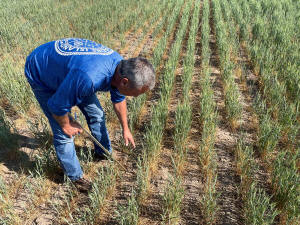Tour estimates lowest Kansas winter wheat yield in over two decades
 Send a link to a friend
Send a link to a friend
 [May 19, 2023]
By Tom Polansek [May 19, 2023]
By Tom Polansek
MANHATTAN, Kansas (Reuters) - Wheat yield potential in Kansas was
estimated at 30.0 bushels per acre (bpa) on Thursday by crop scouts on
an annual Wheat Quality Council tour, the lowest since at least 2000.
The figure in the biggest U.S. winter wheat producer is below the
five-year crop tour average of 45.62 bushels per acre from 2017-2022,
reflecting the impact of months of drought. No tour was held in 2020 due
to the coronavirus pandemic.
The U.S. Agriculture Department on May 12 estimated yields at 29 bushels
per acre in Kansas.
Farmers, grain traders and food companies are watching crop conditions
closely as the U.S. government expects domestic wheat stocks to fall to
a 16-year low. A poor crop from the United States, the world's No. 5
wheat exporter, leaves the world more vulnerable to shortages and could
result in higher food prices.
Tour scouts on average projected the Kansas harvest at 178 million
bushels, below the USDA's estimate for 191.4 million and last year's
harvest of 244.2 million due to expectations that many farmers won't
bother to harvest their wheat.

In most of the 652 fields the tour checked, scouts could see the ground
through the wheat crop because plants were thin and short. When crops
are in good shape, they form a canopy over the soil.
One field in Marion County, Kansas, had visible cracks in the soil on
Thursday. Plants that would normally be about 30 inches (76 cm) tall
were only 20 inches (50 cm) due to dryness.
"You can tell that this is not normal for this part of the country,"
said Dave Green, executive vice president of the Wheat Quality Council.
[to top of second column]
|

Gary Millershaski, a farmer and scout on
the Wheat Quality Council's Kansas wheat tour, inspects winter wheat
stunted by drought near Syracuse, Kansas, U.S., May 18, 2022.
Picture taken May 18, 2022. REUTERS/Julie Ingwersen/File Photo

Some farmers in western Kansas said rains helped improve the crop in
recent weeks. They want more rain, along with cool temperatures,
between now and harvest in about four to six weeks.
Experts caution that rains now are arriving too late to
significantly benefit yields in many places.
"In southern Kansas, it's getting to the stage where it's too late,"
said Joel Widenor, an agricultural meteorologist with the Commodity
Weather Group. "Sure, (rain) will help out a little ... but it
certainly won't have the impact that some of the earlier rains had."
Another round of more widespread showers is expected in the last
week of May that could benefit wheat in northern Kansas, where crops
are less mature and still developing, Widenor said.
In Healy, Kansas, located in the western third of the state, wheat
grower Vance Ehmke said he is living rain-to-rain and already
expecting the worst harvest in his 48 years of farming.
"If it quits raining, we're just dead meat," Ehmke said.
(Reporting by Tom Polansek; additional reporting by Julie Ingwersen
in Chicago; editing by Jonathan Oatis)
[© 2023 Thomson Reuters. All rights
reserved.]This material may not be published,
broadcast, rewritten or redistributed.
Thompson Reuters is solely responsible for this content.
 |